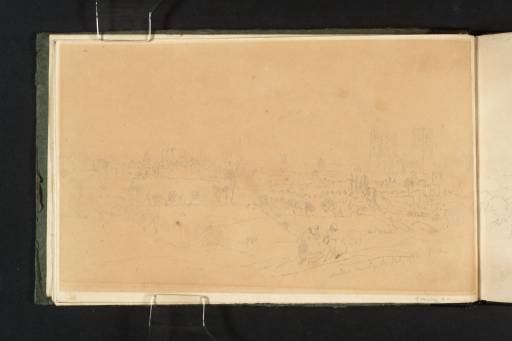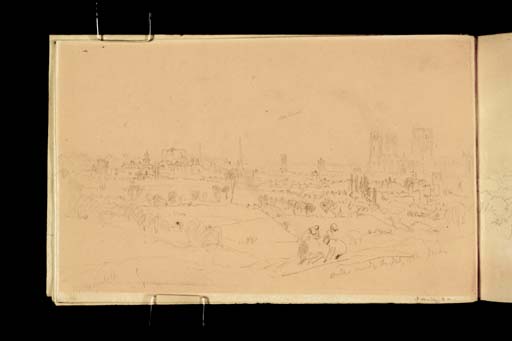Joseph Mallord William Turner York from the South-East, from Lamel Hill Windmill 1816
Image 1 of 2
Joseph Mallord William Turner,
York from the South-East, from Lamel Hill Windmill
1816
Joseph Mallord William Turner 1775–1851
Folio 3 Verso:
York from the South-East, from Lamel Hill Windmill 1816
D11376
Turner Bequest CXLVI 3a
Turner Bequest CXLVI 3a
Pencil on white wove paper, 125 x 200 mm
Inscribed by Turner in pencil ‘Steps the new Castle’ (?), bottom left; ‘Miller mending the Sails of the Mill’, bottom right; ‘Sun through’ in sky to left
Inscribed by Turner in pencil ‘Steps the new Castle’ (?), bottom left; ‘Miller mending the Sails of the Mill’, bottom right; ‘Sun through’ in sky to left
Accepted by the nation as part of the Turner Bequest 1856
References
1909
A.J. Finberg, A Complete Inventory of the Drawings of the Turner Bequest, London 1909, vol.I, p.422 as CXLVI 3a, as ‘... another similar view [to 2a–3 View from the outskirts of York]’.
This is the left half of a double-page spread, continued to right on folio 4 recto (D11377) opposite, recording the view from the windmill on Lamel Hill, looking north-west across the city of York.
Lamel Hill is about half a kilometre south-east of Walmgate bar, just south of the Heslington Road. It is an antique earthwork mound that served as an artillery emplacement during the Civil War, and after that as the site of a windmill. From the evidence of Turner’s sketch, the windmill was a substantial late seventeenth-century postmill, and it appears to have remained in use until about 18301. The panorama pans from left to right to include York Castle and the Debtor’s prison with its lantern; Clifford’s Tower; the spire of All Saints, North Street; the spire of St Mary’s, Castlegate; the tower of All Saints, Pavement; the small tower of St Denys, Walmgate, with behind it the larger tower of St Croix, Pavement (destroyed 1883); then the centre of the view is dominated by the south-east aspect of York Minster with below it Walmgate Bar on the city walls and the tower of St Margaret Walmgate behind; and finally the tower and church of St Lawrence.2 The view closes at the right with the looming form of Lamel Hill windmill, with the Hambledon Hills in the distance, and below, somewhere in the Layerthorpe area, another postmill. Turner’s note of the sun in the north-west indicates evening.
The site marked the northern edge of the open common of Walmgate Stray and the view was already well-known through engravings of York from the South-East by Edmond Barker (1718, copy at York City Art Gallery) and Samuel and Nathaniel Buck (1745, copy at York City Art Gallery).3 By the time of Turner’s visit in 1816 the site was home to The Retreat, a revolutionary Quaker-owned initiative devoted to the humane care of the mentally ill.4 The mound of Lamel Hill, was later taken into the grounds of The Retreat and the windmill was replaced by a gazebo. Tree growth, subsequent building and the high brick walls of the modern Retreat complex now obscure the view.
A sketch in the Yorkshire 1 sketchbook, Tate D10909 (Turner Bequest CXLIV 22a) records a view from nearby.
David Hill
January 2009
The engravings are reproduced in the catalogue of York through the Eyes of the Artist, York City Art Gallery, 1990, nos. 144, 117.
The Retreat first opened in 1796, and pioneered approaches to the treatment of mental health, based on a regimen of health, light, fresh air and kindly treatment. This was quite different to the often brutal conditions elsewhere. One is forced to wonder whether Turner knew of it, especially given that his own mother had been incarcerated in Bethlem Hospital in London when he was young. There is, however, no evidence in the sketch that he was aware of it.
How to cite
David Hill, ‘York from the South-East, from Lamel Hill Windmill 1816 by Joseph Mallord William Turner’, catalogue entry, January 2009, in David Blayney Brown (ed.), J.M.W. Turner: Sketchbooks, Drawings and Watercolours, Tate Research Publication, December 2013, https://www


